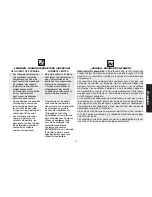
17
English
lowed. The following routine maintenance schedule is geared to an
outfit in a normal working environment operating on a daily basis.
If necessary, the schedule should be modified to suit the condi-
tions under which your compressor is used. The modifications will
depend upon the hours of operation and the working environment.
Compressor outfits in an extremely dirty and/or hostile environment
will require a greater frequency of all maintenance checks.
NOTE: See Operation section for the location of controls.
Checking Safety Valve (Fig. 1)
WARNING:
Hot surfaces. Risk of burn. Tubes, pump head, and
surrounding parts are very hot, do not touch (see the Hot Surfaces
identified in Fig. 2). Allow compressor to cool prior to servicing.
WARNING:
Risk of bursting. If the safety valve does not work
properly, over-pressurization may occur, causing air tank rupture or
an explosion.
WARNING:
Risk from flying objects. Always wear certified
safety equipment: ANSI Z87.1 eye protection (CAN/CSA Z94.3) with
side shields.
Before starting compressor, pull the ring on the safety valve to
make sure that the safety valve operates freely. If the valve is stuck
or does not operate smoothly, it must be replaced with the same
type of valve.
Checking Air Filter (Fig. 1)
WARNING:
Hot surfaces. Risk of burn. Tubes, pump head, and
surrounding parts are very hot, do not touch (see the Hot Surfaces
identified in Fig. 2). Allow compressor to cool prior to servicing.
A dirty air filter will not allow the compressor to operate at full
capacity. Keep the air filter clean at all times.
1. Ensure Auto/Off switch (B) is in the OFF Position.
2. Allow unit to cool.
3. Remove the 3 phillips screws and washers from the pump
head.
4. Remove the small plate, being careful not to drop anything on
the exposed valves.
5. Carefully lift out the air filter and screens. NOTE: The screen
edges are sharp.
6. Place cleaned or new air filter between the screens and insert
back into grooves. Refer to the Replacement Parts under
Service.
7. Place the plate back onto the pump head, insert the screws
and washers, tighten the screws.
CAUTION:
Risk of unsafe operation. Do not operate without air
filter.
Draining Air Tank (Fig. 3)
WARNING:
Risk of unsafe operation. Air tanks contain high
pressure air. Keep face and other body parts away from outlet of
drain. Use eye protection [ANSI Z87.1 (CAN/CSA Z94.3)] when
draining as debris can be kicked up into face.
WARNING:
Risk from noise. Use ear protection (ANSI S12.6
(S3.19) as air flow noise is loud when draining.
NOTE:
All compressed air systems generate condensation that accu-
mulates in any drain point (e.g., tanks, filter, aftercoolers, dryers). This
condensate contains lubricating oil and/or substances which may be
regulated and must be disposed of in accordance with local, state,
and federal laws and regulations.
1. Set the Auto/Off switch to “Off”.
2. Pull ring on safety valve allowing air to bleed from the tank until
tank pressure is approximately 20 psi. Release safety valve
ring.
3. Drain water from air tank by opening drain valve (counterclock-
Содержание DXCMLA3706056
Страница 87: ...87 Español NOTES ...
















































